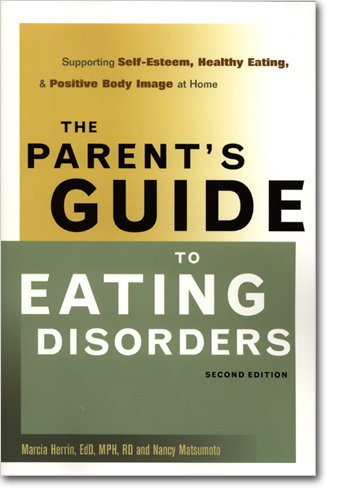
The Parent's Guide to Eating Disorders
Supporting Self-Esteem, Healthy Eating, & Positive Body Image at Home
by Marcia Herrin & Nancy Matsumoto
“Supporting Self-Esteem, Healthy Eating & Positive Body Image at Home”
“I cried as I read excerpts to my husband remembering how different it was for us when our daughter struggled just seven years ago and I celebrate the authors’ respect for parents as an essential resource in successful treatment.”
– Kitty Westin, Founder and President of the Anna Westin Foundation, a non-profit foundation started by Anna Westin’s family after her death from anorexia nervosa in 2000
“Marcia Herrin is a consummate clinician who has built up one of the top notch college eating-disorder treatment programs in the country. Her many years of clinical practice treating children and their families and her no-nonsense approach make this book an important resource.”
– Russell Marx, MD, Director of the University Medical Center at Princeton Eating Disorders Program (from the Foreword)
Over the past 50 years, experts have seen progressively younger and younger kids –preteen-aged and below – struggle with food, exercise and weight obsession. Recent studies have shown that eating disorders are also increasing in populations previously thought immune to such problems including males and other cultures. [See Attached.]
Parenting a child with an eating disorder is one of the most difficult challenges anyone can face. In the new bookTHE PARENT’S GUIDE TO EATING DISORDERS (Gürze Books/September 2007/$18.95), Marcia Herrin, Founder of the Dartmouth College Eating Disorders Program, and journalist Nancy Matsumoto, teach parents everything they need to know about recognizing, preventing, and sensitively solving childhood eating disorders.
Herrin’s practical approach involves families as an essential resource in successful treatment, places no blame upon them for their child’s disorder, and illustrates how effective solutions can begin at home, at virtually no cost other than a healthy investment in time, effort, and love.
“The latest clinical research shows that families play a critical role in turning around an emerging or full-blown eating disorder,” notes Herrin. “All parents want their child to be healthy and happy but are often at a loss as to how to get them on the road to recovery.”
After presenting a thorough overview of the different types of eating disorders and disordered eating, as well as a comprehensive overview of the medical symptoms associated with them, the authors provide concrete strategies for parents and siblings who want to help.
THE MAUDSLEY METHOD and PAMS
Here the authors introduce the highly effective and relatively new treatment, known as the Maudsley method, which coupled with detailed food and exercise plan form the therapeutic heart of the book. Studies have shown that the Maudsley approach is one of the most effective treatments for adolescent anorexia and touts a 90 percent recovery rate five years after completion of the standard treatment of six months to a year.
In essence the Maudsley method puts parents in charge of all refeeding efforts through the use of coached family meals. The approach shifts the focus from actively unearthing the causes of eating disordered to actively engaging in behavioral recovery that will get the child to eat normally again.
Inspired by the overwhelmingly positive results of incorporating the Maudsley method in her own practice, Herrin went on to develop a nutritional-focused take on the treatment, which she calls Parent-Assisted Meals and Snacks (PAMS). Combining the use of PAMS with Herrin’s easy to follow Food Plan – a detailed blueprint for daily meals and snacks – will over time normalize a child’s eating and ensure that she/he is getting enough nutrients from the five major food groups. (For a downloadable version of Herrin’s Food Plan please visit: www.childhoodeatingdisorders.com)
The authors devote an entire chapter to recognizing and managing relapses and conclude by highlighting the warning signs that professional help is needed to supplement the efforts being made at home, outlining the professional resources available to parents, and how best to assess which would be most helpful.
“During the 20 years I have spent as a nutritionist helping families suffering from eating disorders, I have been privileged to work with hundreds of families and have witnessed the cycle of shock, frustration, despair, hope, and ultimately, recovery occur again and again. The best gift a parent can give a child struggling with eating issues is the ability to eat in an organized, carefree fashion, to give up diets, and to be educated enough to make sound confident food choices,” writes Herrin. THE PARENT’S GUIDE TO EATING DISORDERSarms parents with the information and strategies they need to give this precious and life-giving gift to their children.